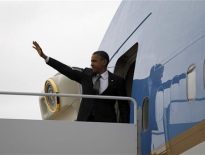NEW DELHI (AP) — India announced the successful test launch Thursday of a new nuclear-capable
missile that would give it the ability to strike the major Chinese cities of Beijing and Shanghai for the first time, a
significant step forward in its aspirations to become a regional and world power.
missile, with a range of 5,000 kilometers (3,100 miles), being launched from Wheeler Island off India's east coast,
Thursday, April 19, 2012. India announced the successful test launch Thursday of the new nuclear-capable missile that would
give it the capability of striking the major Chinese cities of Beijing and Shanghai for the first time. (AP Photo/Indian
Ministry of Defense)
The Agni-V missile, with a range of 5,000 kilometers (3,100 miles), still requires a battery of tests
and must clear other bureaucratic hurdles before it can be inducted into India’s arsenal in a few years. But officials
hailed the launch as proof the country has taken its place among the world’s most powerful and scientifically advanced
nations.
“The nation stands tall today,” Defense Minister A.K. Antony said, according to the Press Trust of
India.
The test came just days after North Korea’s failed rocket launch, but sparked none of the same global
condemnation aimed at Pyongyang, an internationally isolated regime that has been banned by the U.N. from testing missile
technology.
China is far ahead of India in the missile race, with intercontinental ballistic missiles capable of
reaching anywhere in India. Currently, the longest-range Indian missile, the Agni-III, has a range of 3,500 kilometers (2,100
miles) and falls short of many major Chinese cities.
“At the moment there is a huge assymetry in China’s favor,” said
C. Uday Bhaskar, the former head of the Institute of Defense Studies and Analyses. After it adds the missile to its arsenal,
however, “India’s deterrent profile in the region would be appropriately burnished.”
Video released by the government
showed the Agni-V taking off from a small launcher on what appeared to be railroad tracks at 8:07 a.m. from Wheeler Island
off India’s east coast. It rose on a pillar of flame, trailing billows of smoke behind, before arcing through the
sky.
The missile hit an altitude of more than 600 kilometers (370 miles), its three stages worked properly and its
payload was deployed as planned, the head of India’s Defense Research and Development Organization, Vijay Saraswat, told
Times Now news channel.
“India has emerged from this launch as a major missile power,” he said.
Chinese Foreign
Ministry spokesman Liu Weimin declined to discuss the launch at a regular news conference Thursday, saying only that India
and China should work together as strategic partners.
But a state TV report on the launch enumerated the missile’s
shortcomings and a Chinese newspaper warned India not to get arrogant and overestimate its strength.
“India should be
clear that China’s nuclear power is stronger and more reliable. For the foreseeable future, India would stand no chance in
an overall arms race with China,” said an editorial in the Global Times, which is published by the Communist Party’s
official mouthpiece the People’s Daily.
It also warned India not to work with Western allies to try to contain
China.
“If it equates long range strategic missiles with deterrence of China, and stirs up further hostility, it could
be sorely mistaken,” it said.
The Agni-V is a solid-fuel, three-stage missile designed to carry a 1.5-ton nuclear
warhead. It stands 17.5 meters (57 feet) tall, has a launch weight of 50 tons and was built mainly with Indian-made
technology at a reported cost of 25 billion rupees ($486 million). It can be moved across the country by road or rail and can
be used to carry multiple warheads or to launch satellites into orbit.
The missile will need four or five more trials
before it can be inducted into India’s arsenal at some point in 2014 or 2015, Indian officials said.
Prime Minister
Manmohan Singh hailed the launch as “another milestone in our quest to add to the credibility of our security and
preparedness and to continuously explore the frontiers of science.”
Others called the test a major step in India’s
fight to be seen as a world power.
“India has today become a nation with the capability to develop, produce, build
long-range ballistic missiles and today we are among the six countries who have this capability,” Saraswat
said.
Analysts say France, Russia, China and the United States also have this technology, while Israel is believed to
have developed such missiles.
Others were more cautious.
Defense analyst Rahul Bedi said much needed to be
done, noting that a government that is notoriously slow with defense decisions now needs to push forward with more tests,
work out strategic doctrines, define targets, figure out manufacturing issues and how many missiles to build among a host of
other issues.
“We need to build on today’s success … to build in a very capable dissausive deterrence capability,”
he said. “But going back to past records I don’t know if we can sustain it.”
India and China fought a war in 1962 and
continue to nurse a border dispute. India has also been suspicious of Beijing’s efforts to increase its influence in the
Indian Ocean in recent years.
India already has the capability of hitting anywhere inside archrival Pakistan, but has
engaged in a splurge of defense spending in recent years to counter the perceived Chinese threat.
The Indian navy took
command of a Russian nuclear submarine earlier this year, and India is expected to take delivery of a retrofitted
Soviet-built aircraft carrier soon.
The new Agni, named for the Hindi word for fire, is part of this military buildup
and was designed to hit deep inside China, Bedi said.
Government officials said the missile should not be seen as a
threat because India had a no-first-use policy and its missiles were used only for deterrence.
The test came days
after North Korea’s failed long-range rocket launch. North Korea said the rocket was launched to put a satellite into space,
but the U.S. and other countries said it was a cover for testing long-range missile technology.
In Washington, State
Department spokesman Mark Toner said the United States urges all nuclear-capable states to exercise restraint regarding
nuclear capabilities.
“That said, India has a solid non-proliferation record,” he told a news briefing. “They’re
engaged with the international community on non-proliferation issues.”





